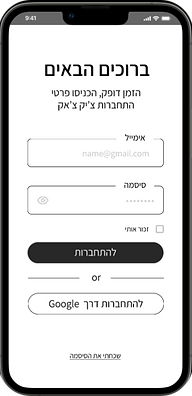My Projects
Complex systems design, Human factor engineering, User empowerment design
(as part of my BA)
Time Tracker
A complex system that enables employees to track their working hours, salary, apply for shifts, ask special requests and various other activities. The system can be customized according to any user requirements. In order to enable convenient and reliable navigation within the system, we emphasized Norman and Nielsen's heuristics, such as 'Flexibility and efficiency of use'. We also relied on identification processes instead of recall, in order to reduce the amount of time and effort needed to perform operations in the system. In addition, we have categorized the system buttons in a way that is clear to the user according to Gestalt's law of proximity.
See an Animated interactive prototype
Review a Project presentation and the full Design document.









Autonomous Vehicle
During the Ergonomics course, we designed a fully autonomous vehicle, where the only actions the user needs to perform are starting the vehicle and setting the destination.
Analysis included Adopting the interface to the actions it's designed to perform, designing the system ergonomically and choosing the optimal place for the display and controls.
The design was based on Norman & Nielsen's heuristics and applied principles with emphasize on users who are new to the system. Heuristics such as 'Error Prevention' and 'User control and freedom'.
Review the full Design document.
Communiway
This project aimed to improve an existing digital product using UX principles that we learned.
During the research process, we interviewed stakeholders and users using questionnaires. During our analysis, we reviewed the business models of our competitors. Additionally, we investigated what unresolved pain points exist in competing products. To represent different groups in the society within the product, we created personas. In order to allow the user to move around easily and quickly without unnecessary delays related to using the application, we determined that an intuitive and minimalist interface should be created. We designed our own business model, use cases, user script and information architecture. Our design decisions were based on the principles of Ben Schneiderman and Norman & Nielsen's heuristics.
Review the full Design document.











User Empowerment Design
As part of the user empowerment seminar as part of the degree, we implemented empowerment in a digital product.
We chose the "Maccabi Health Services" app.
As part of the research process, we developed personas and mapped their abilities, skills, traits, strengths, and weaknesses. During our research, we also conducted interviews and based our findings on those interviews.
At the end, we designed problems, solved them, and applied relevant theories to them.
Review a Project presentation.

Trial Flow Improvement Project
During my internship at DUDA, I took part in a research project that aimed to improve the trial flow experience. We used a step-by-step method called the Double Diamond to thoroughly investigate and make changes.
Our approach was multifaceted. Initially, we engaged in exploratory research. This helped us to identify, define, and articulate challenges. At the same time, it facilitated the extraction of insightful observations, honed problem definitions, and the illumination of previously unaddressed gaps in user requirements.
We followed important ideas from experts like Fogg's Motivation Theory, Norman and Nielsen's 10 helpful heuristics, and Robert Cialdini's theory about the psychology of the persuasion. We also mixed these ideas with real-world input from design practitioners, making our way of doing things better using 'The Coach Model' from the world of user-empowerment design.
In conclusion, my internship at DUDA offered me the invaluable opportunity to contribute to a research-driven transformation utilizing a holistic blend of methodologies and theories. This experience enriched my understanding of user-centerd design.
Review a website presenting our project.
Treating Glossophobia Through VR
We embarked on a research journey to find innovative ways to help people overcome their fear of public speaking, also known as glossophobia. One promising solution we explored was the use of Virtual Reality (VR) as a tool for therapy. Since the fear of public speaking is widespread, we decided to look into how immersive technology like VR could be used to provide psychological support. We took a thorough look at existing research, psychological theories, and the applications of VR. Our investigation revealed an interesting connection between VR's immersive experiences and a psychological technique called exposure therapy, which is known to help with phobias.
In simple terms, we discovered that by creating situations in VR where individuals could practice speaking to simulated audiences, we might be able to help them gradually become more comfortable and confident in real-life public speaking situations. This approach could potentially reduce the fear associated with glossophobia and help people improve their speaking skills. Our research not only shows our commitment to using technology for mental well-being but also highlights how Virtual Reality can make a positive impact on real-world challenges.
Review the full article we created about improving glossophobia through VR treatment.







